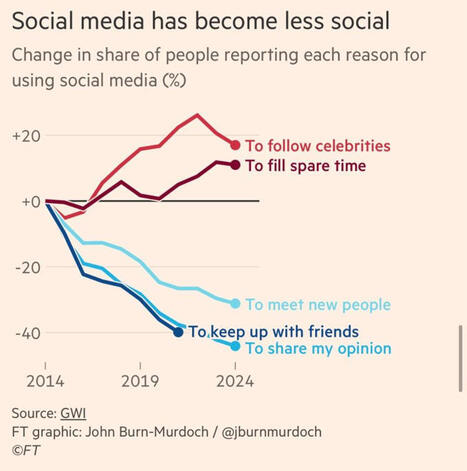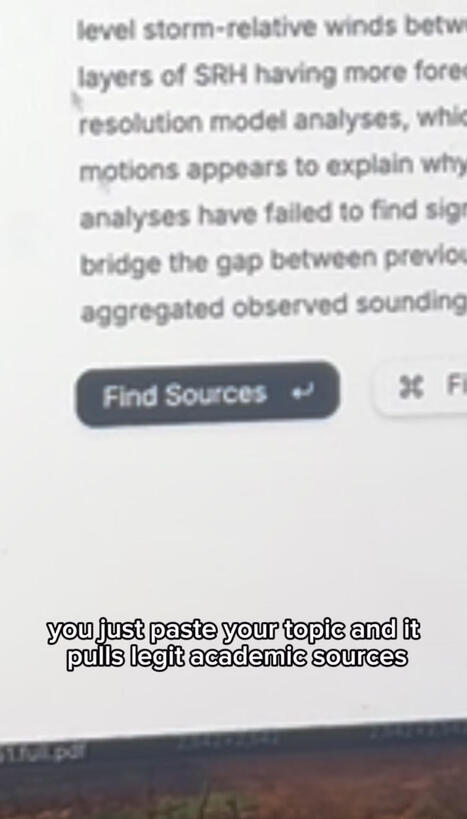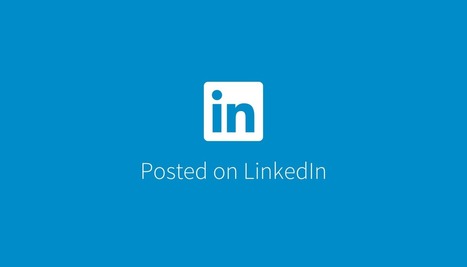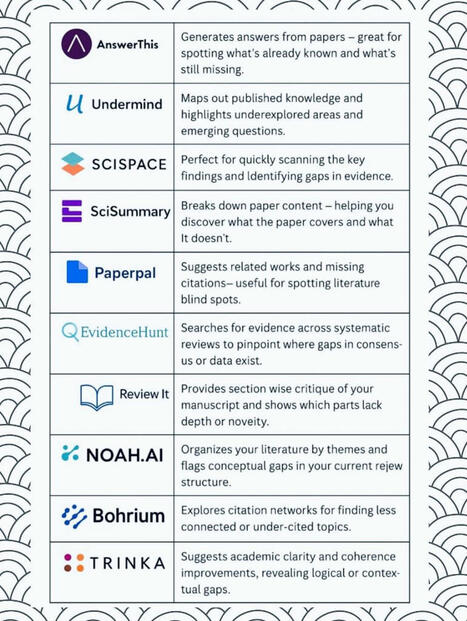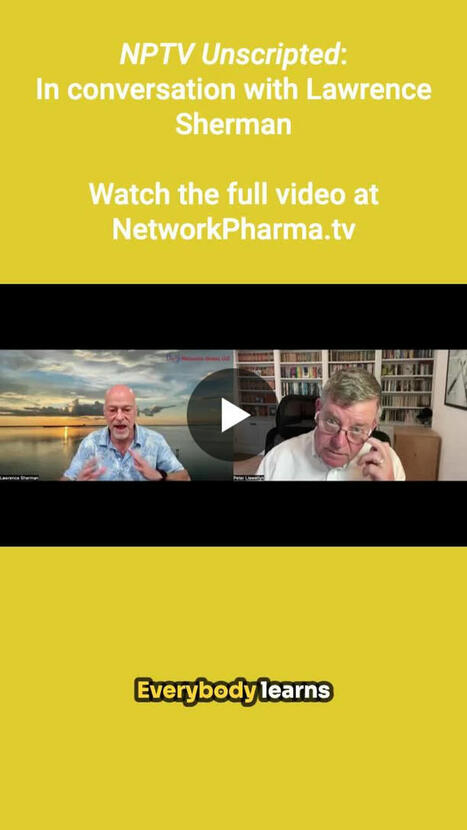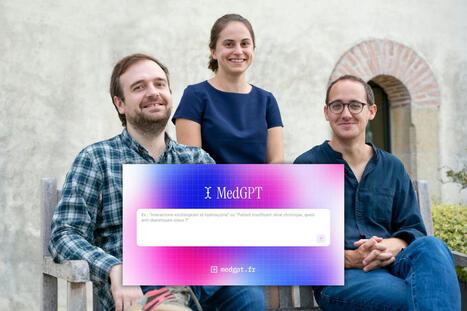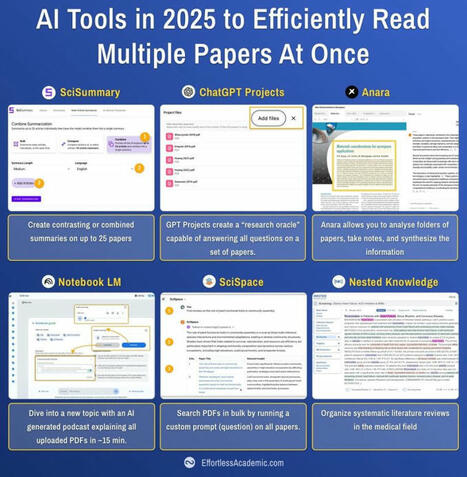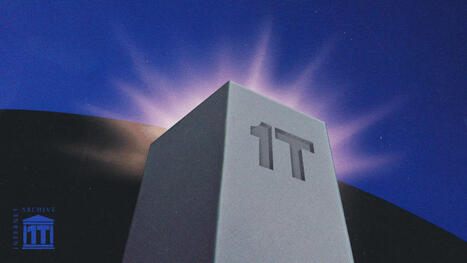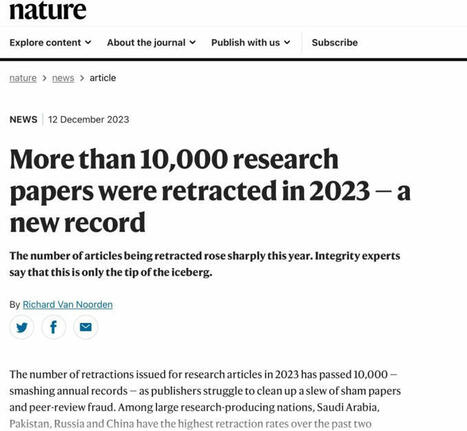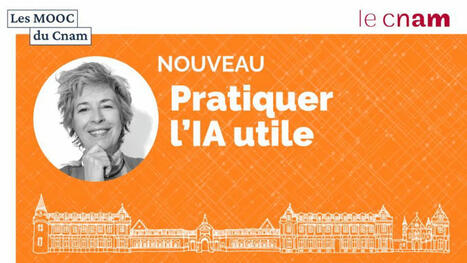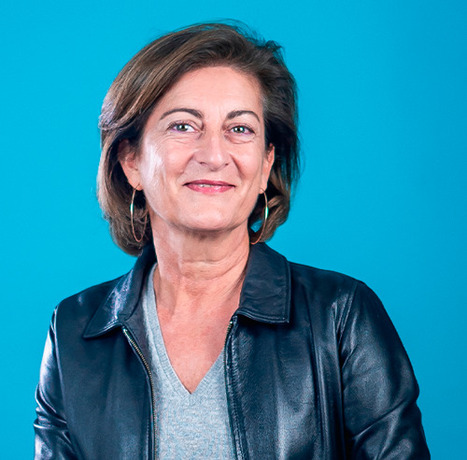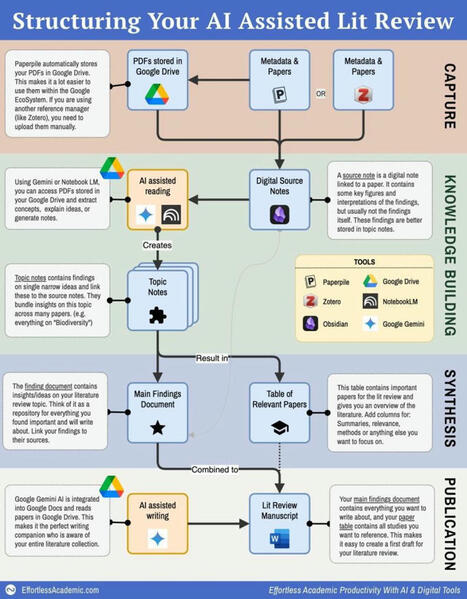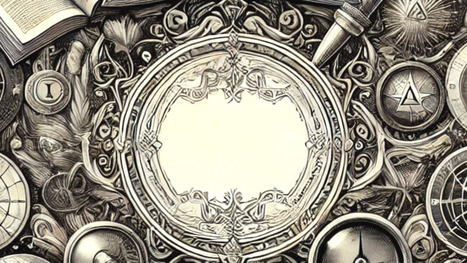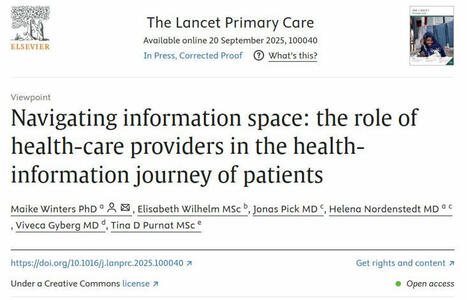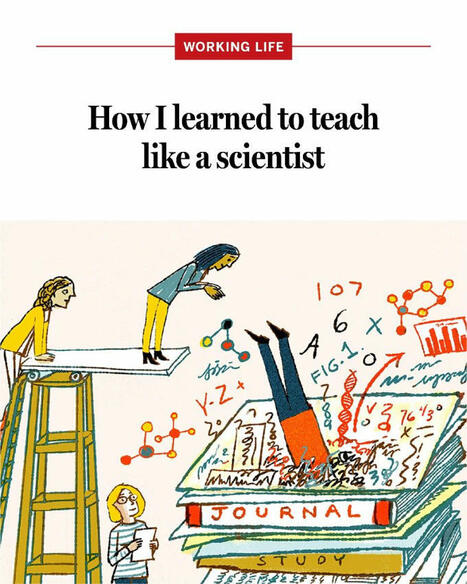 Your new post is loading...
 Your new post is loading...

|
Scooped by
Gilbert C FAURE
October 13, 2013 8:40 AM
|
is a personal Notebook Thanks John Dudley for the following tweet "If you like interesting snippets on all sorts of subjects relevant to academia, information, the world, highly recommended is @grip54 's collection:" La curation de contenus, la mémoire partagée d'une veille scientifique et sociétale

|
Scooped by
Gilbert C FAURE
October 16, 4:54 AM
|
Les plateformes sociales entrent dans une nouvelle ère : celle du désenchantement. La baisse mondiale du temps passé en ligne, combinée à l’arrivée massive de contenus générés par l’IA, révèle un tournant dans les usages.
1️⃣ L’ère du contenu ultra-transformé
Meta et OpenAI lancent leurs propres plateformes de vidéos générées par IA. Leur pari : que les utilisateurs aient encore envie de créer et surtout de consommer toujours plus de vidéos. Sauf que cette logique pousse à l’extrême ce que l’auteur du Financial Times appelle un « contenu ultra-transformé ». Dopamine garantie, valeur informationnelle quasi nulle…. Et perte de sens assurée.
2️⃣ Le reflux de l’attention
Les chiffres sont très intéressants. Selon une analyse du cabinet GWI, le temps passé sur les réseaux a atteint un pic en 2022 avant de chuter de près de 10 % fin 2024. Les 16 ans et plus y consacrent en moyenne deux heures et vingt minutes par jour. Et même les jeunes surconnectés décrochent les premiers.
💎En fait, les plateformes, devenues des « machines à capter l’attention », ne sont plus vraiment sociales.
👉 À lire absolument : https://on.ft.com/4gP83eW Have we passed peak social media?

|
Scooped by
Gilbert C FAURE
October 14, 1:59 PM
|
🌟 Find Academic Sources Faster — Let Sourcely Do the Heavy Lifting! 🌟
Tired of endless searching for credible sources? Meet your new research companion!
✅ Instant Sources
Paste your essay

|
Scooped by
Gilbert C FAURE
October 13, 4:53 AM
|
Let’s get cooking! 🍚
Once considered a luxury during times of scarcity in China, pork fat with rice (猪油拌饭) is a timeless comfort dish. A chunk of jade-like solidified lard melts over a steaming bowl of rice, releasing its rich aroma and silky flavor.
Discover how to cook this classic favorite, below: #FriedRiceDay

|
Scooped by
Gilbert C FAURE
October 13, 2:39 AM
|
🤖 Comme les agrégateurs de nouvelles du type Discover, Google Actualités ou Yahoo News, ChatGPT sélectionne et hiérarchise des publications, jouant ainsi sur la découvrabilité des médias d’information. Mais comment opère-t-il ce tri ?
Pour le savoir, le chercheur Olivier Koch (Université Sorbonne Paris Nord, Carism) a mené une petite expérience...
Les résultats à découvrir ici 👉 https://lnkd.in/ecYpb-2C

|
Scooped by
Gilbert C FAURE
October 11, 10:56 AM
|
IA et info scientifique - bibliothèque de l'EPFL de Lausanne - Soutien aux étudiants - site très bien structuré et documenté.
https://lnkd.in/ey5-CXXR

|
Scooped by
Gilbert C FAURE
October 11, 8:10 AM
|
PhD Students - Top 10 AI tools for finding research gaps
𝟏. AnswerThis (YC F25)
- Generates answers from papers
- Great for spotting what's already known
- And what's still missing.
↳ Link: https://lnkd.in/dJNc8NsW
𝟐. Undermind
- Maps out published knowledge
- Highlights underexplored areas
- And emerging questions.
↳ Link: https://lnkd.in/dsXFM7WU
𝟑. SciSpace
- Perfect for quickly scanning the key findings
- And identifying gaps in evidence.
↳ Link: https://lnkd.in/dXsHe2bq
𝟒. SciSummary
- Breaks down paper content
- Helping you discover what the paper covers
- and what it doesn't.
↳ Link: www.scisummary.com
𝟓. PaperPal
- Suggests related works and missing citations
- Useful for spotting literature blind spots.
↳ Link: https://lnkd.in/d_HFd4QT
𝟔. EvidenceHunt
- Searches for evidence across systematic reviews
- Pinpoint where gaps are in consensus or data exist.
↳ Link: https://lnkd.in/dzsEPrtx
𝟕. Review-it
- Provides section-wise critique of your manuscript
- Shows which parts lack depth or novelty.
↳ Link: www.review-it.ai
𝟖. Noah.AI Technologies
- Organizes your literature by themes
- Flags conceptual gaps in your current review structure.
↳ Link: https://lnkd.in/dknZbniz
𝟗. Bohrium
- Explores citation networks
- Finds less connected or under-cited topics.
↳ Link: https://lnkd.in/dm5nhyRH
𝟏𝟎. Trinka.ai
- Suggests academic clarity and coherence improvements
- Reveals logical or contextual gaps.
↳ Link: https://bit.ly/4cdETCB
#research #gap | 13 comments on LinkedIn

|
Scooped by
Gilbert C FAURE
October 10, 4:46 AM
|
It was great fun talking with Peter Llewellyn about learning facilitation!

|
Scooped by
Gilbert C FAURE
October 9, 5:49 AM
|
« Les médecins ne devraient plus aller sur Google ou ChatGPT : MedGPT est là, fiable et souveraine » - Synapse, la célèbre startup co-fondée par le Dr Louis Létinier il y a 8 ans, vient de lancer le très attendu MedGPT ! L’équivalent de ChatGPT mais fiable réservée uniquement médecins. Il nous présente son IA générative

|
Scooped by
Gilbert C FAURE
October 8, 3:39 AM
|

|
Scooped by
Gilbert C FAURE
October 6, 7:55 AM
|
If you want to extract ideas from several papers, use any of these six tools:
They can make your lit review faster and more thorough.
AI enables us to move away from reading papers and towards understanding ideas.
You feed AI the right information and ask the right questions but the AI decides where the answer comes from.
We are moving towards an idea-driven science paradigm, which will change the way we do science and alleviate the struggles we are having now about information overload with ease.
These are the tools I am using:
✅ SciSummary:
Save time by combining 325 articles into one easy-to-digest summary, giving you a clear overview of key insights.
✅ ChatGPT Projects:
Dive deep into the contextual nuances of your papers, enabling a comprehensive analysis that goes beyond surface-level information.
✅ Notebook LM:
Transform your analysis into podcast-style summaries, making complex research easier to digest.
✅ SciSpace:
Organize and compare data easily by visualizing your PDFs in a customizable, interactive table that suits your workflow.
✅ Anara:
Anara is a synthesis engine for academic papers. Upload your PDFs to have drawn-out conversations with the AI. Anara will always provide references to the PDFs when answering your questions.
✅ Nested Knowledge:
Perfect for medical field reviews—structure, organize, and efficiently manage your review process even when AI tools are restricted.
✨ Boost your research workflow and take control of your time. These tools are game-changers for anyone looking to streamline the paper-reading process. 📚
--
Want to know which tools you shouldn't be missing out on?
Get the free PDF on 13 indispensable AI tools for academics + how to use them + promo codes:
https://lnkd.in/gJVVfJkm

|
Scooped by
Gilbert C FAURE
October 6, 2:11 AM
|
This October, the Internet Archive will celebrate an extraordinary milestone: 1 trillion web pages preserved and available for access via the Wayback Machine. Calendar of Events | Impact Stories | Support the Internet Archive | Press Kit Since 1996, the Internet Archive has worked with libraries and partners around the world to build a shared digital library of humanity’s online history: capturing websites large and small—from breaking news to forgotten personal pages—so they remain accessible for future generations. The series of events scheduled throughout October will highlight the memories, makers, and movements that have made this achievement possible, and will look ahead to the future of web preservation as we continue building the web’s collective memory together. Calendar of Events October 7—The Vast Blue We: Del Sol Quartet at the Internet Archive 7:00-8:15pm PTInternet Archive300 Funston Avenue, San Francisco & ONLINERegister now for IN-PERSON or VIRTUAL tickets An evening to celebrate human collaboration—how billions of individual actions weave together into something vast and beautiful. Through music of Del Sol Quartet with new works by Erika Oba and Sam Reider, we mark the staggering scale of one trillion archived web pages available via the Wayback Machine. Join us for an interactive evening of live music reflecting the wonder of what we can achieve together and the power of our own voices. October 9—A Conversation with Sir Tim Berners-Lee and Brewster Kahle Building and Preserving the Web: A Conversation with Sir Tim Berners-Lee and Brewster Kahle7:30pm PTThe Commonwealth Club of California110 The Embarcadero, San Francisco & ONLINERegister now for IN-PERSON or VIRTUAL tickets Sir Tim Berners-Lee and Brewster Kahle will be in conversation about the rise of the internet, its continuing and explosive impact on society, the importance of the Internet Archive and other developing issues in the growth and use of the internet. October 16—Library Leaders Forum 2025 (VIRTUAL) 10:00-11:30am PTONLINERegister now for VIRTUAL tickets In our virtual Library Leaders Forum, you’ll hear from Internet Archive staff and partners about our emerging library services and updates on existing efforts. How do libraries empower research in the 21st century? Join in our discussion! October 21—Doors Open 2025: Go Behind the Scenes at the Physical Archive 6:00-8:00pm PTRichmond, CaliforniaRegister now for IN-PERSON tickets The Internet Archive is excited to offer a behind-the-scenes tour of the physical collections of books, music, film, and video in Richmond, California. With this special insider event we are opening the doors to an often unseen place. See the lifecycle of physical materials: donation, preservation, digitization, and access. Also, samples from generous donations and acquisitions of books, records, microfiche, and more will be on display. October 22—The Web We’ve Built: Celebrating 1 Trillion Web Pages Archived 5:00-10:00pm PT7:00-8:00pm PT Live StreamInternet Archive300 Funston Ave, San FranciscoRegister now for IN-PERSON or VIRTUAL tickets This October, the Internet Archive’s Wayback Machine is projected to hit a once-in-a-generation milestone: 1 trillion web pages archived. That’s one trillion memories, moments, and movements—preserved for the public and available to access via the Wayback Machine. We’ll be commemorating this historic achievement on October 22, 2025, with a global event: a party at our San Francisco headquarters and a livestream for friends and supporters around the world. More than a celebration, it’s a tribute to what we’ve built together: a free and open digital library of the web. Join us in marking this incredible milestone. Together, we’ve built the largest archive of web history ever assembled. Let’s celebrate this achievement—in San Francisco and around the world—on October 22. October 27—Wayback to the Future: Celebrating the Open Web 5:00-8:00pm PTRiggs Library, Georgetown UniversityHealy Hall, Library Walk, Washington, DC 20057Register now for IN-PERSON tickets Join the Foundation for American Innovation, the Massive Data Institute and the Internet Archive at Georgetown University’s historic Riggs Library for Wayback to the Future: Celebrating the Open Web—Past, Present, and Possible. The open web was once defined by experimentation, decentralization, and possibility. The technological advancements were driven by the desire for a place where new voices and ideas could flourish. Today, consolidation and walled gardens challenge that vision. Together, we’ll look back at the internet’s origins to spark a forward-looking conversation about how to keep the web free, open, and innovative. Speakers include: Moderator: Luke Hogg — Director of Technology Policy, FAIBrewster Kahle — Founder & Director, Internet ArchiveVint Cerf — Chief Internet Evangelist, GoogleCindy Cohn — Executive Director, Electronic Frontier FoundationJon Stokes – Co-founder, Ars Technica Impact Stories The 1 trillion archived webpages are more than just numbers—they represent real impact on people’s lives, research, and memory. From immigration cases to personal histories, academic research to investigative journalism, the Wayback Machine has become an essential public resource that preserves the web for all. Canadian musician David Samuel relied on archived concert programs in the Wayback Machine to secure U.S. residency. Paul Lindner built a digital memorial to his late wife by recovering her online presence. Researchers at King’s College London use web archives to track the evolution of fake news and open data. Investigative trainers call the Wayback Machine “a precious tool” for exposing deleted evidence. Share Your Story What does the web mean to you? How has the Wayback Machine helped you remember, research, or recover something important? Share your story. Support the Internet Archive Help us continue preserving the web for generations to come. Donate today! Press Kit Interested in producing a story about the 1 trillion milestone? Our online press kit includes impact stories from users, facts & figures about the Internet Archive & Wayback Machine, and Then/Now screenshots of popular web sites. Contact info is available in the press kit.

|
Scooped by
Gilbert C FAURE
October 5, 11:01 AM
|
Is science facing an integrity crisis?
A recent analysis in Nature revealed a shocking statistic: over 10,000 scientific papers were retracted in 2023 alone, a new record. This isn't just about small errors; it's a symptom of a much larger, more organized problem.
At the heart of this issue are "paper mills"—fraudulent operations that produce and sell fake research papers. Aided by AI, they can generate synthetic text with bizarre signatures like “tortured phrases” to mimic legitimate scientific writing.
While we trust the editorial system to be our defense, the evidence shows it is being successfully subverted:
- A PNAS analysis argues that these fraudulent papers are slipping through editorial filters at scale by exploiting gaps in the review system.https://https://lnkd.in/e7upVsUP
- An investigation in the journal Bioengineered found that during a suspect period, roughly 25–30% of articles showed signs of data manipulation or duplication.https://arxiv.org/abs/2503.21267
- The damage lingers even after a paper is caught. A JAMA Network Open paper documented how retracted paper mill articles are still being cited in systematic reviews years later, contaminating the evidence base in critical fields like oncology. https://lnkd.in/eMD4T5iM
- The BMJ has also highlighted the persistent patterns found in these retracted papers. https://lnkd.in/eMb_cYej
The sheer volume of these publications proves that our current detection methods—both human and automated—are not foolproof. This is more than just academic misconduct; it's a systemic threat to the integrity of the entire scientific record.
How can we, as a community, better protect our research ecosystem from this organized fraud?
#ResearchIntegrity #AIethics #PaperMill #PeerReview #ScholarlyPublishing #ScientificTrust | 20 comments on LinkedIn
|

|
Scooped by
Gilbert C FAURE
October 16, 4:58 AM
|

|
Scooped by
Gilbert C FAURE
October 15, 4:38 AM
|
New paper just published with Shaydanay Urbani and Eric Wang. We wanted to understand how people searched for health information on AI-powered technologies (specifically ChatGPT, Alexa and Gemini Overviews on Google Search results), so we interviewed 27 people while watching their behavior and asking for additional information about why they were doing certain things and what they would do with the results. https://lnkd.in/eMfZUcxD
tl;dr : Participants integrated AI tools into their broader search routines rather than using them in isolation. ChatGPT was valued for its clarity, speed, and ability to generate keywords or summarize complex topics, even by users skeptical of its accuracy. Trust and utility did not always align; participants often used ChatGPT despite concerns about sourcing and bias. Google’s AI Overviews were met with caution—participants frequently skipped them to review traditional search results. Alexa was viewed as convenient but limited, particularly for in-depth health queries. Platform choice was influenced by the seriousness of the health issue, context of use, and prior experience. One-third of participants were multilingual, and they identified challenges with voice recognition, cultural relevance, and data provenance. Overall, users exhibited sophisticated “mix-and-match” behaviors, drawing on multiple tools depending on context, urgency, and familiarity.
Fascinating project, and as ever, people's behavior tends to be much more complex and nuanced than headlines would suggest.

|
Scooped by
Gilbert C FAURE
October 13, 9:22 AM
|
Nous avons un cadeau pour vous : un tout nouveau MOOC gratuit sur l’intelligence artificielle ! 🎁
Quel que soit votre métier – industrie, services, médecine, art – l’IA peut devenir votre meilleur allié.
Ce MOOC a été conçu pour vous aider à la pratiquer concrètement, selon 3 parcours :
> Débutants : pour découvrir pas à pas l’IA.
> Professionnels : pour ceux qui ont déjà testé et veulent aller plus loin.
> Experts : pour créer et utiliser des agents IA.
💡 Vous y trouverez des contenus exclusifs issus d’expériences du monde entier, bien au-delà des classiques formations des GAFAM ou des YouTubers.
L’objectif ? Vous permettre de transformer vos compétences et votre métier grâce à l’IA.
Réalisé au Cnam (Conservatoire national des arts et métiers) avec le #LearningLabHumanChange
📅 Rendez-vous le 13 octobre 2025 à 18h pour le lancement !
Conservatoire National des Arts et Métiers CAIRE | 52 comments on LinkedIn

|
Scooped by
Gilbert C FAURE
October 13, 4:52 AM
|
Discuter, s’informer, se distraire, consommer… aujourd’hui, plus que jamais les réseaux sociaux façonnent les comportements, les habitudes et les décisions d’achat. Auparavant effectués sur le web, la majorité des usages passent désormais par les réseaux sociaux, pour suivre ses proches, se divertir et se tenir informé de l’actualité.C’est entre autres ce que relève l’Observatoire des Réseaux Sociaux de Médiamétrie, nouvelle étude semestrielle qui dresse le panorama de ces plateformes devenues centrales dans les usages et dans les investissements publicitaires.

|
Scooped by
Gilbert C FAURE
October 12, 1:12 AM
|
🔎 Les plateformes en ligne restent très perméables à la désinformation, selon une nouvelle étude du consortium Science Feedback.
➡️ 6 plateformes (Facebook, Instagram, LinkedIn, TikTok, X, YouTube) ont été examinées. La désinformation reste massivement présente sur toutes les plateformes. Les contenus trompeurs bénéficient d’une plus large visibilité et les mécanismes de démonétisation de ces contenus sont encore insuffisants, notamment sur YouTube.
📊 Quelques chiffres clés :
◾ Prévalence de la désinformation et contenus abusifs : TikTok (34 %) > X (32 %) > Facebook (27 %) > YouTube (22 %) > Instagram (19%) > LinkedIn (8 %).
◾ Une "prime à la désinformation" : les comptes peu crédibles génèrent jusqu’à 8 fois plus d’engagement que les sources fiables sur certaines plateformes.
◾ Monétisation persistante : 76 % des chaînes peu crédibles sur YouTube restent éligibles à la publicité.
💬 Ces constats interrogent la conformité des pratiques des plateformes avec les obligations du DSA en matière de réduction des risques systémiques. Cette analyse constitue la première évaluation à grande échelle des indicateurs structurels prévus par le Code de conduite européen sur la désinformation. Elle confirme une tendance au désengagement des plateformes en matière de désinformation que les régulateurs européens, dont le CSA avaient déjà constaté dans une précédente étude.
🔗 Notre analyse : https://lnkd.in/dYx5DbNK
🔗 En savoir plus sur le DSA : https://lnkd.in/ek2wqihT
🔗 L'étude complète :https://lnkd.in/eAf53wzt
En bref ↘️

|
Scooped by
Gilbert C FAURE
October 11, 8:21 AM
|
If you feel overwhelmed by a lit review, you just need a strategy.
Here is an AI-assisted structure for thorough literature reviews:
🔵 1 - Capture Phase
In this phase, your goal is to find impactful review papers, not every single paper. In fact, the fewer relevant papers you find, the easier your literature review will go.
I recommend using PaperPal as your reference manager because it automatically uploads PDFs into Google Drive, making it much easier to use AI on them.
🔵 2 - Knowledge Building
To build your knowledge, take notes in your own words on recurring topics in your field. Using Obsidian, you can link these notes and store information on the papers you have read. This makes your notes easy to find and use. Upload your PDFs to Google Drive. This allows Gemini and Notebook LM to access these papers, helping you understand and identify concepts.
🔵 3 -Synthesis phase
Once you have extensive notes on 10-20 topics, it's time to start synthesising the review. I use two detailed documents:
(1) Main Findings: This is a free-text note where you dump all relevant findings that make sense to mention in your literature review. Don't worry about the structure (You can later use AI to format it). The purpose of this document is to craft a narrative for your literature review.
(2) Table of relevant papers: This table mentions all the papers you have read and has columns for different aspects of them. For instance, a summary, relevance, methods, study area, period, etc. The purpose of this document is to remember which papers you want to cite in your review.
The key is to store everything relevant in these two documents.
🔵 4 - Writing phase
With the two documents from the previous phase, you can start drafting out a manuscript. Drop both documents into AI and ask it to outline a first draft for your manuscript. If the main findings already have a structure, this will be reflected in the output of the AI. Most importantly, Google's Gemini Has access to all your papers through Google Drive and can integrate them into the manuscript skillfully.
This AI output should remain a draft. Polish it using your own words and always double-check.
--
Here is my guide on the top 13 indispensable tools for academics:
https://lnkd.in/gJVVfJkm
(Use these to finish your lit review in record time)

|
Scooped by
Gilbert C FAURE
October 11, 5:11 AM
|
L'ère numérique nous a confrontés à une « surcharge informationnelle » sans précédent, une réalité qui affecte notre concentration et notre capacité à hiérarchiser les priorités. Dans les domaines de la cyberdéfense, de la géopolitique et de l'innovation, la rapidité de la prise de décision est vita

|
Scooped by
Gilbert C FAURE
October 9, 6:34 AM
|
Health information journeys now begin well before a consultation. Patients often arrive having already Googled symptoms, watched health advice on TikTok, or even asked an AI chatbot. And research shows many go back online after their appointment to double check what their clinician said. Some never make it to seeing a provider after finding answers online.
In my conversations with colleagues, we often think about how the information environment shapes health across the socioecological model. In this piece, we zoomed in on one layer that is easy to overlook: the patient–provider relationship. What happens when the information space patients move through before and after visits changes their expectations of what makes them feel listened to and supported?
Our new Viewpoint in Lancet Primary Care explores these questions.
Special thanks to Maike Winters, who sparked the idea and led the writing.
Some of the reflections we share:
1/ The “information space” is crowded. Algorithms, influencers, and even predatory journals often outshine clinical voices
2/ Trust between patients and providers depends less on facts alone, and more on empathy, listening, and continuity of care
3/ Tackling questions, concerns, narratives, and misinformation is extra work for providers, but it’s central to making patients feel heard and supported.
4/ Building literacies around navigating the information environment could help both patients and providers navigate this new terrain together.
You can read the article here (open access): https://lnkd.in/dnxWefZZ
Elisabeth Wilhelm Jonas Pick Helena Nordenstedt Viveca Gyberg | 13 comments on LinkedIn

|
Scooped by
Gilbert C FAURE
October 9, 4:37 AM
|
🦈 Mise à jour le 2 octobre, la liste des revues recommandables est disponible sur notre site : https://swll.to/3Pzmpae
3 revues ont été ajoutées depuis juillet
Angiogenesis
Med (New York, N.Y.)
Pharmacology research & perspectives
Cette liste est destinée à guider les auteurs de manuscrits du domaine de la santé dans le choix de revues auxquelles il leur est recommandé de soumettre leurs travaux de recherche. Elle est aussi destinée à guider la participation aux activités du processus éditorial (relecteurs, éditeurs). Sont plus particulièrement concernés les candidats à des fonctions ou des promotions hospitalo-universitaires et les étudiants de master et doctorat des domaines de la santé cherchant à publier leurs travaux originaux de recherche.
À partir de la liste de la Faculté de médecine de Sorbonne Université constituée en septembre 2021, une liste non exhaustive de revues scientifiques, présumées non prédatrices et dans lesquelles il est recommandé de soumettre des articles pour publication a été élaborée par la Conférence des Doyens de médecine et le CNU santé.

|
Scooped by
Gilbert C FAURE
October 6, 8:05 AM
|
Academic life was a lot simpler in the humanities and social sciences when simply finding a document guaranteed originality, says Disha

|
Scooped by
Gilbert C FAURE
October 6, 2:13 AM
|
To save its future, Google licensed Reddit’s chaos. Now AI slop and human slop are locked in a race to the bottom.

|
Scooped by
Gilbert C FAURE
October 5, 11:09 AM
|
It’s important for journalists to be aware of predatory journals because such journals pose a threat for the integrity of science journalism.

|
Scooped by
Gilbert C FAURE
October 5, 10:58 AM
|
“I will miss the creativity of teaching.”
On #WorldTeachersDay, check out this Working Life from a retired professor emeritus on how she challenged students to think beyond facts—and how she learned to teach like a scientist. https://scim.ag/4nuLMWj
|



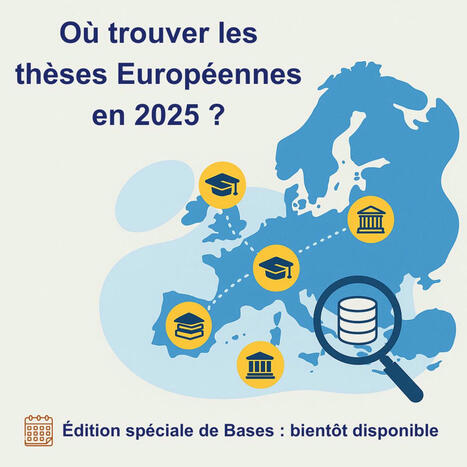


 Your new post is loading...
Your new post is loading...
